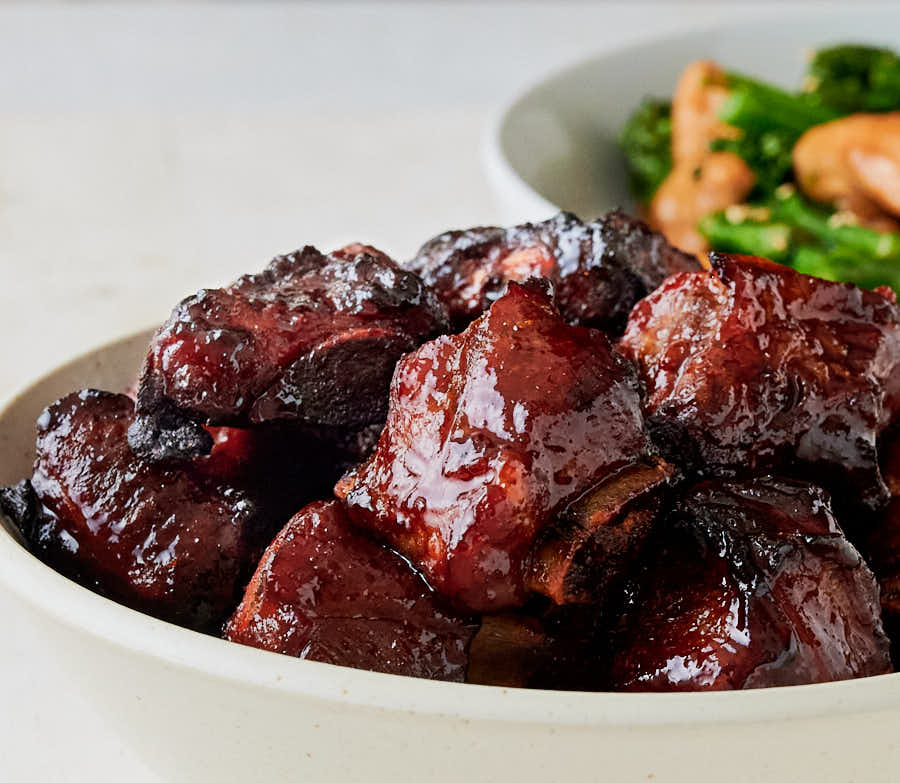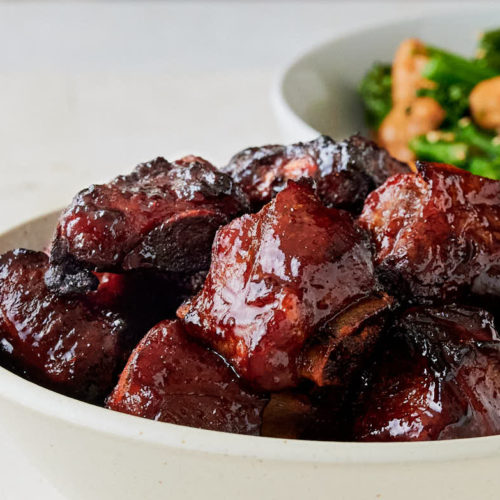Char siu ribs. Chinese sticky ribs. I don’t know which name is better. What I do know these ribs are seriously delicious.
A little bit salty. A little bit sweet. Sticky. Loaded with umami. And porky rib goodness. There is just nothing here not to love.
Chinese takeout flavour at home
I like ribs. Correction. I love ribs. I’m always looking for ways to feed my rib addiction. Char siu ribs deliver.
This isn’t anything you’ll get if you visit China. Not that I’ve seen anyway. This is something you might get at your local Chinese restaurant.
Except it isn’t really that either. They serve ribs in a bunch of different ways at Chinese restaurants where I am.
But they don’t do char siu ribs. I’m not sure why. I think maybe because it doesn’t fit the formula.
But it should. It hits all the notes. Char siu flavour. Spare ribs. Addictive flavour. Fun to eat.
And in absolutely no way authentic. Just like pretty much everything else on a Chinese takeout menu. I think it’s perfect.
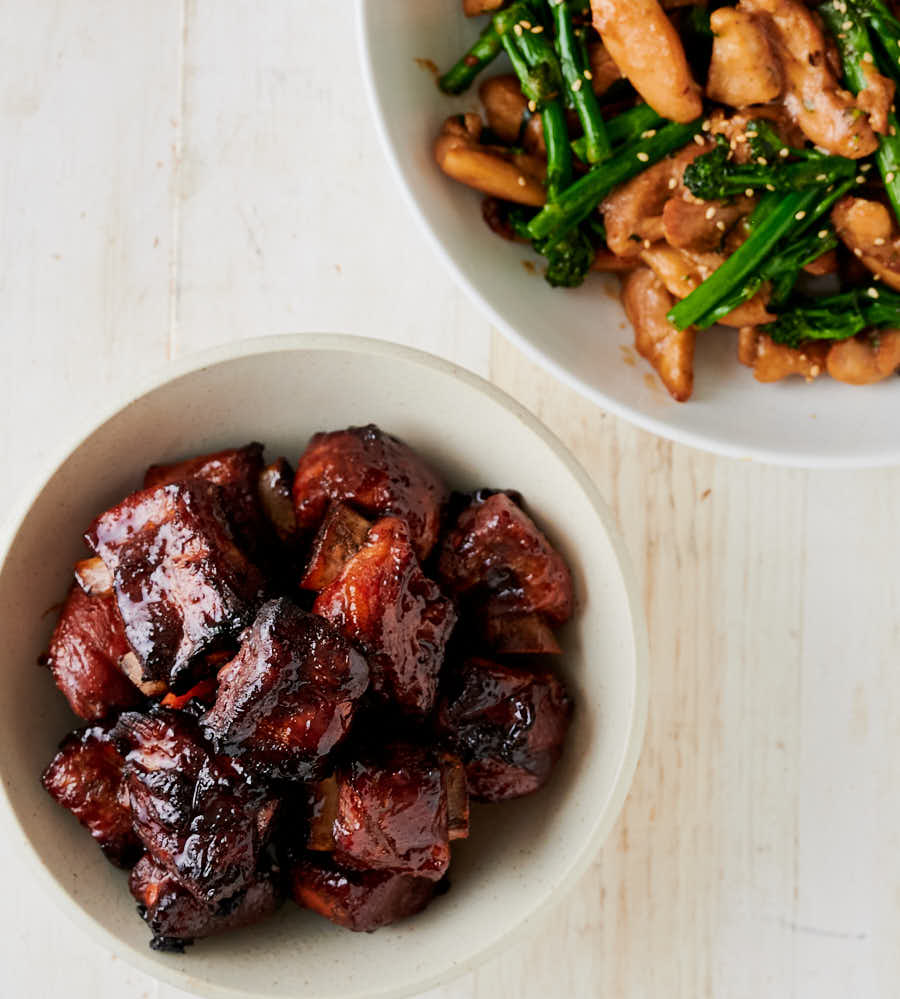
A different approach
Char siu recipes are all pretty similar. Hoisin. Soy. Shaoxing. Honey. Fermented red bean curd. Or food colouring.
That’s the easy version. Straight forward. Only slightly more difficult than buying a jar of char siu sauce. Gets you similar results.
At the other end of the spectrum there are incomprehensibly complicated recipes. For the hardcore char siu purist.
This is somewhere in the middle. I am not a hardcore char siu purist. If you’re looking for absolute char siu nirvana I am not your guy.
But I’m also not interested in run of the mill. So I will try harder than most.
Deep in the back of the internet I found a hardcore purist that was using red miso. I love miso. So I tried it. Now I’ll never make char siu ribs without it.
Red miso adds saltiness. Like the fermented red bean curd. But it adds that major miso umami power too. That’s the gee whiz. It’s like char siu magic paste.
It doesn’t add the deep red though. For that you have to cheat.

Char siu is supposed to be red
I used food colouring in this recipe. I’m not particularly proud of that. I generally try to stay away from dyeing my food. It’s just weird.
But I’m a food blogger. And people expect that reddish brown tint to their char siu. So I had a choice.
I could send you hunting for fermented bean curd. And you could have that in your fridge for the next 20 years looking for another reason to use it.
Or I could suggest a little red food colouring. It’s cheaper. It takes up way less room.
And you can use it to make unnecessarily red tandoori chicken. So it is not completely useless.
Your call. You know your audience. If they won’t miss the colour just leave it out. Or get some fermented red bean curd. Keep it real.
I know. This isn’t real. I did it on purpose. I’m not making the most perfect char siu ever here.
I’m making ribs. In the style of char siu.
That’s a subtle difference. But you’ll understand why I’ve done it when you taste these ribs.
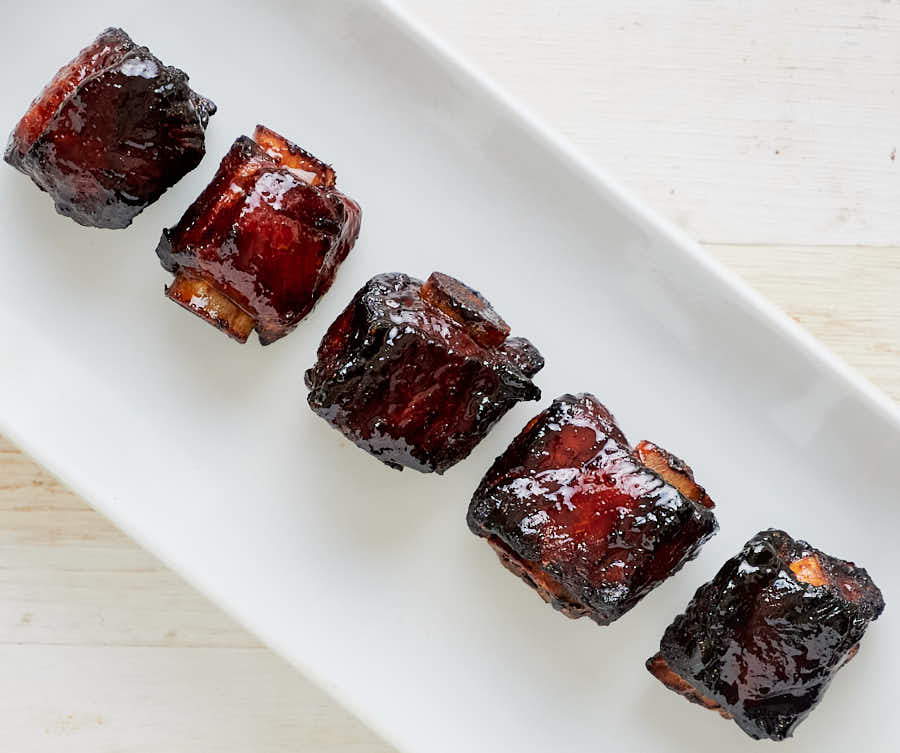
This is slow food
You can’t rush ribs. That’s just a fact. So you can’t rush char siu ribs. Tough cuts need slow, gentle cooking to bring out their best.
It’s like Texas BBQ. You want tender ribs? Falling off the bone but juicy? Low and slow is the way to go.
When I make BBQ I like to run between 225F and 275F. I don’t agonize too much. As long as I’m in this range I know I’ll be OK. Takes a long time to cook ribs at 225F. A long time.
So I push it a bit. As high as I can. But there is a limit. Push things to 325F and you get tough ribs. I don’t recommend it.
Back things off to around 290F and things start to work. Ribs are about taste. And texture.
A little bit of tug as the tender rib meat comes off the bone. That’s the golden rule for ribs.
That’s what I’m after here.
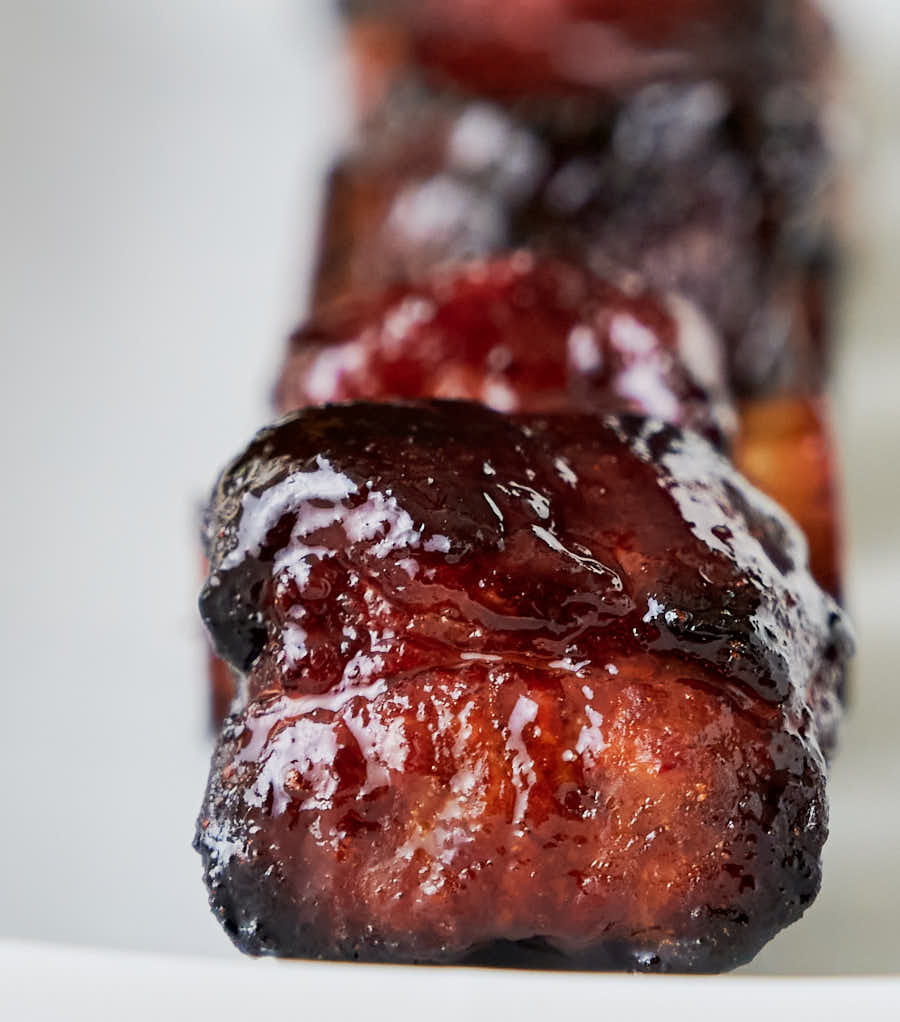
When char siu meets ribs
Char siu ribs are ribs. Not pork shoulder. Not pork neck fillet. Ribs. So I want them to eat like ribs. The way ribs should be. With a char siu twist.
So I took a little inspiration from an old BBQ rib recipe I’ve been making for years. That recipe is about hoisin and sesame oil and chili paste and apricot jam.
Don’t worry. There’s no apricot jam here. But it is something you should consider for your next BBQ.
I went a little sweeter. A little heavy on the hoisin. Light on the five spice. Honey at the end. To make things sticky.
And soy in the glaze. To give it that salty sweet goodness that is perfect with ribs.
So don’t leave me comments telling me the char siu you had in Hong Kong was different. Or that your local does it different. I already know that.

Char siu ribs smackdown – you be the judge
The day I took the pictures for this post I bought a nice chunk of char siu from one of the better Chinese groceries in town.
That was my “scientific” control. Taste the ribs. Taste the char siu. I wasn’t going for exactly the same. But I wanted a similar flavour profile.
And I surprised myself. I liked the ribs better. It wasn’t a dramatic difference. But there was no doubt in my mind.
You’ll have to decide for yourself of course. Don’t take my word for it. Only you know what you like best.
I’m willing to bet you’ll like char siu ribs though. Deep umami char siu flavour. And pork ribs. I don’t think you can go wrong.
This one probably isn’t on your local takeaway menu. But I think it should be. I’m betting you will too.
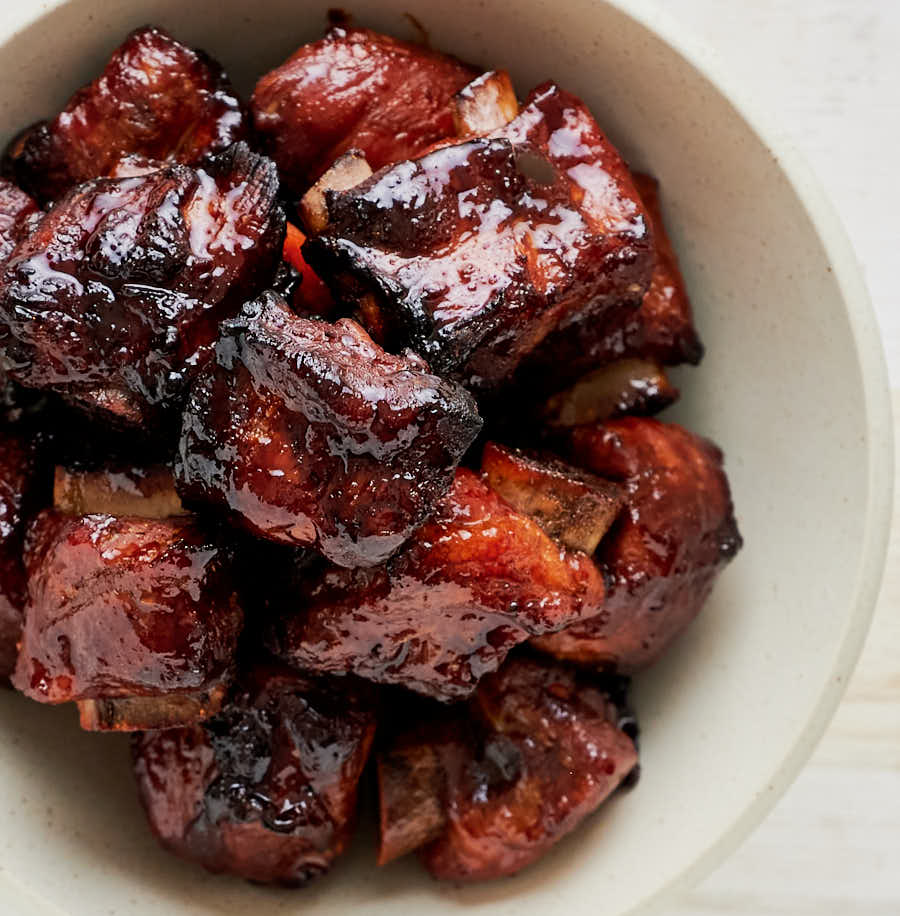
char siu ribs
Ingredients
The marinade and the ribs
- 3 lbs pork spare ribs – Asian cut or not, separated.
- 2 tbsp hoisin
- 1 tbsp shaoxing wine
- 1 tbsp red miso – also called aka miso
- 2 tbsp light soy
- 2 tbsp brown sugar
- 1/2 tsp Chinese five spice – available from your local Asian grocery
- 1/2 tsp monosodium glutamate – there's a lot of umami coming from the miso so this isn't super critical but it's tasty
- 1/4 tsp white pepper
- 1/4 tsp granulated garlic
- 1/4 tsp red food colouring – the powder. This is optional of course. Purely cosmetic.
The glaze
- 1 tbsp light soy
- 1 tbsp dark soy
- 1 tbsp hoisin
- 2 tbsp honey
- 1 tsp sesame oil
Instructions
Marinate the ribs
- Combine all the ingredients listed in the marinade section above except the ribs. Stir to combine.
- Transfer the ribs to a large ziplock bag or Tupperware with tight fitting lid. Add the marinade. Coat the ribs with the marinade. In the bag that means sealing the bag and gently shaking/massaging. In a Tupperware that means using tongs or a large spoon to mix things up. Either way there's food colouring in the marinade so be careful. You do not want to touch anything raw with food colouring in it. That's an embarrassing lesson I've learned the hard way.
- Refrigerate overnight. Flip the bag in the morning. Or give the Tupperware a shake.
Make the glaze
- Combine all the ingredients in a small bowl. Honey is a pain to get mixed in so microwave everything until warm and stir. It works way better if you warm it up a bit.
- Set aside.
Cook the ribs
- There's a little setup for this one.
- Preheat your oven to 290F. Full disclosure. I use a convection oven. Always.
- Grab a big baking sheet pan and a rack. Cover the sheet pan with aluminium foil. Put the rack onto the foil.
- Place the ribs on the rack so there is space between the ribs. Leave a little corner open.
- Place the baking sheet pan in the preheated oven. Pour about a cup of water into the sheet pan through that little corner you left open. You don't want much more than a cup because it becomes awkward getting the sheet pan in and out of the oven. You'll understand when you do it.
- Roast the ribs for about 40 minutes. Remove from the oven and flip each rib using tongs. Return the ribs to the oven and cook another 20 minutes or so.
- Check the internal temperature of the ribs. You are going for about 195F in a thick one. It's going to take a while yet but better to start checking too soon rather than too late.
- Your ribs should be done in about 2 hours. Could be more. Could be less. I don't know how meaty your ribs are. I don't know how accurate your oven is. It could be less than 2 hours. It could be as much as three hours. It's like BBQ. It's ready when it's ready. Super annoying. I know. But it's an unfortunate reality.
- When you hit 195F remove the ribs from the oven. Turn your oven up to 375. When your oven has hit the new temperature baste each rib using a basting brush. Don't go crazy. There isn't that much glaze.
- Return to the oven and roast for about 3-5 minutes. You are looking for things to colour up.
- Remove the ribs from the oven, flip each rib and baste with the remaining glaze.
- Return the glazed ribs to the oven and cook for another 3-5 minutes. If they don't look like the pictures hit them with just a little bit of broiler action. Be careful though. There's lots of sugar here. Sugar burns fast.
- Remove the ribs from the oven, let cool slightly and serve.

